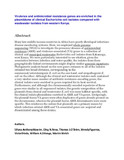| dc.contributor.author | Wawire, Sifuna Anthony | |
| dc.contributor.author | Reva, Oleg N. | |
| dc.contributor.author | O'Brien, Thomas J. | |
| dc.contributor.author | Figueroa, Wendy | |
| dc.contributor.author | Dinda, Victor | |
| dc.contributor.author | Shivoga, William A. | |
| dc.contributor.author | Welch, Martin | |
| dc.date.accessioned | 2021-07-09T10:30:40Z | |
| dc.date.available | 2021-07-09T10:30:40Z | |
| dc.date.issued | 2021-07 | |
| dc.identifier.uri | https://doi.org/10.1016/j.meegid.2021.104784 | |
| dc.identifier.uri | https://www.sciencedirect.com/science/article/abs/pii/S1567134821000812?via%3Dihub | |
| dc.identifier.uri | http://r-library.mmust.ac.ke/123456789/1772 | |
| dc.description.abstract | Many low-middle income countries in Africa have poorly-developed infectious disease monitoring systems. Here, we employed whole genome sequencing (WGS) to investigate the presence/absence of antimicrobial resistance (AMR) and virulence-associated (VA) genes in a collection of clinical and municipal wastewater Escherichia coli isolates from Kakamega, west Kenya. We were particularly interested to see whether, given the association between infection and water quality, the isolates from these geographically-linked environments might display similar genomic signatures. Phylogenetic analysis based on the core genes common to all of the isolates revealed two broad divisions, corresponding to the commensal/enterotoxigenic E. coli on the one hand, and uropathogenic E. coli on the other. Although the clinical and wastewater isolates each contained a very similar mean number of antibiotic resistance-encoding genes, the clinical isolates were enriched in genes required for in-host survival. Furthermore, and although the chromosomally encoded repertoire of these genes was similar in all sequenced isolates, the genetic composition of the plasmids from clinical and wastewater E. coli was more habitat-specific, with the clinical isolate plasmidome enriched in AMR and VA genes. Intriguingly, the plasmid-borne VA genes were often duplicates of genes already present on the chromosome, whereas the plasmid-borne AMR determinants were more specific. This reinforces the notion that plasmids are a primary means by which infection-related AMR and VA-associated genes are acquired and disseminated among these strains. | en_US |
| dc.language.iso | en | en_US |
| dc.publisher | Science Direct | en_US |
| dc.subject | Virulence , antimicrobial, resistance, genes, enriched ,plasmidome ,clinical, Escherichia, coli, isolates, compared ,wastewater, isolates | en_US |
| dc.title | Virulence and antimicrobial resistance genes are enriched in the plasmidome of clinical Escherichia coli isolates compared with wastewater isolates from western Kenya | en_US |
| dc.type | Article | en_US |

